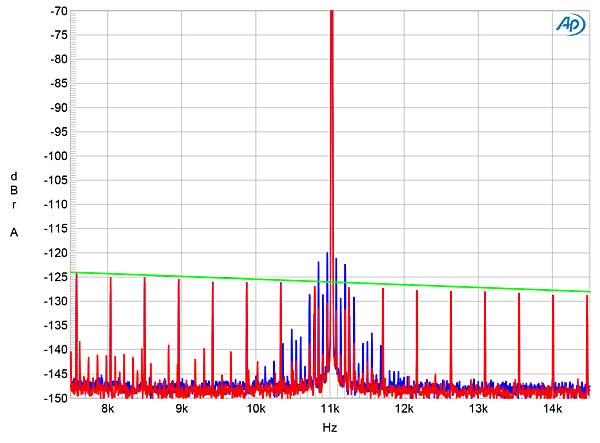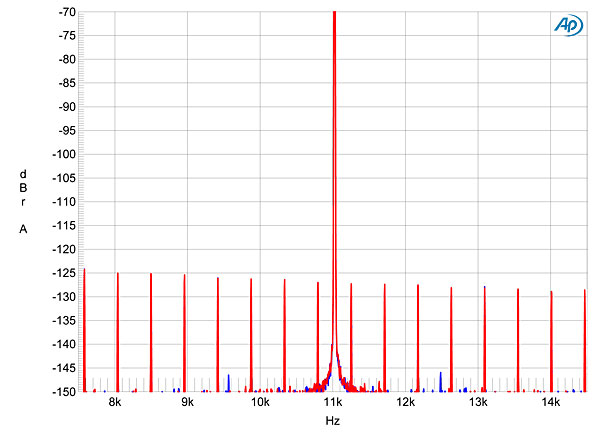Okay, still haven't got an answer on this - could someone please clarify where my thinking may be astray, pleaseOkay, that is the phase noise of a pure audio tone being played - but the phase noise I mentioned was that of the clock, +-25Hz around the master frequency, purely random; in the DAC a factor of 256 comes into play, 256 cycles of that clock are counted before the next audio data sample is clocked in - if the individual cycles being added are random in period then it should average out to be extremely close to the correct period between each audio sample being processed? IOW, I don't see how the jitter of the clock translates to the jitter of an audio sine wave, by the same amount.
-
WANTED: Happy members who like to discuss audio and other topics related to our interest. Desire to learn and share knowledge of science required. There are many reviews of audio hardware and expert members to help answer your questions. Click here to have your audio equipment measured for free!
You are using an out of date browser. It may not display this or other websites correctly.
You should upgrade or use an alternative browser.
You should upgrade or use an alternative browser.
Close in jitter?
- Thread starter Blumlein 88
- Start date
Dividing of the clock using an ideal circuit does not change the profile or spectrum of jitter. Jitter is the max variations of the clock edge over certain number of cycles. The edges will still do that if you divide them down. Here is an example of divide by 2:

As you see by the area of the shaded transitions, they are the same. What changes is the total amount of energy. Every divide by 2 lowers the jitter amplitude by 6 dB. In the case of the question you are asking, random jitter spanning +- 25 Hz will continue to have those same characteristics when divided by N. Its amplitude however gets lowered by 20*log(N).
Did this answer your question?
As you see by the area of the shaded transitions, they are the same. What changes is the total amount of energy. Every divide by 2 lowers the jitter amplitude by 6 dB. In the case of the question you are asking, random jitter spanning +- 25 Hz will continue to have those same characteristics when divided by N. Its amplitude however gets lowered by 20*log(N).
Did this answer your question?
Not quite,Dividing of the clock using an ideal circuit does not change the profile or spectrum of jitter. Jitter is the max variations of the clock edge over certain number of cycles. The edges will still do that if you divide them down. Here is an example of divide by 2:
As you see by the area of the shaded transitions, they are the same. What changes is the total amount of energy. Every divide by 2 lowers the jitter amplitude by 6 dB. In the case of the question you are asking, random jitter spanning +- 25 Hz will continue to have those same characteristics when divided by N. Its amplitude however gets lowered by 20*log(N).
Did this answer your question?
Ken Newton
Active Member
- Joined
- Mar 29, 2016
- Messages
- 190
- Likes
- 47
Not quite,. Turning the problem into a discussion of period, rather than frequency, the jitter of 50Hz in the 11 MHz clock corresponds to a variation of period of the clock pulses of 0.4 psecs. Assuming a completely random distribution of jitter, and assuming absolutely no other factors are involved, the 256 cycles will average out to give a variation of the order of 0.4 psecs of the data clocking pulse, in a 44.1kHz audio stream. Real world CD players "boast" of 200 psecs of effective jitter, so our 0.4 psecs is miles good enough.
Jitter is a periodic variation in time of a clock signal, or a clock synchronized analog signal, from an absolutely stable frequency, called the carrier frequency. Therefore, it has an amplitude specified in units of TIME (seconds). That is where the familiar specification of jitter in picoseconds derives. It also has a frequency, which is to say, a rate at which the time amplitude cycles. So, for example, a 50Hz jitter figure would indicate the frequency or rate the carrier is changing from absolute stability, while seconds would indicate the amplitude of that cycling. This is what you see on an jitter spectrum plot. The vertical axis indicates carrier time displacement amplitude, while the horizontal axis indicates carrier time displacement frequency, which commonly features multiple frequencies of displacement as indicated by multiple discrete spectrum lines.
The best lay explanation I've found, now 10 years old:
http://www.esstech.com/files/4314/4095/4318/sabrewp.pdf

Disclaimer: I have an ESS DAC.
http://www.esstech.com/files/4314/4095/4318/sabrewp.pdf
Disclaimer: I have an ESS DAC.
Getting somewhere ... there is no such thing as "simple" jitter; there are at least 5 ways of measuring misbehaviour that can then be described as jitter - confusion will reign if all the parties are not talking about the same ruler: https://www.sitime.com/support2/documents/AN10007-Jitter-and-measurement.pdf.
Shall go away and digest this, before proceeding ...
Shall go away and digest this, before proceeding ...
Ken Newton
Active Member
- Joined
- Mar 29, 2016
- Messages
- 190
- Likes
- 47
Getting somewhere ... there is no such thing as "simple" jitter; there are at least 5 ways of measuring misbehaviour that can then be described as jitter - confusion will reign if all the parties are not talking about the same ruler: https://www.sitime.com/support2/documents/AN10007-Jitter-and-measurement.pdf.
Shall go away and digest this, before proceeding ...
I find that an easy way to gain an intuitive feeling for how jitter affects the post DAC analog signal is via the following reciprocal principle: Jitter causes the DAC to produce the correct analog value, but at the wrong time instant. This is essenatially the same result as would be produced by a DAC producing an wrong analog value at the correct time instant. In either view, the analog waveform gets distorted.
Absolutely. But it must be noted that this will always be true. You cannot design a system that has zero jitter, therefore anyone with a vested interest in spreading FUD will always be able to wheel out this as a bogeyman. The actual scale of the jitter is irrelevant, because it has to be illustrated with an exaggerated drawing in order to be visible. The fact that the jitter in real systems is 1/1000 (or whatever) of the level that anyone could ever hear is not even part of the 'argument'.I find that an easy way to gain an intuitive feeling for how jitter affects the post DAC analog signal is via the following reciprocal principle: Jitter causes the DAC to produce the correct analog value, but at the wrong time instant. This is essenatially the same result as would be produced by a DAC producing an wrong analog value at the correct time instant. In either view, the analog waveform gets distorted.
Yes. But it's relatively easy to find, use parts that nominally, by the specs, are good enough such that even on a maximum level 20kHz sine wave the jitter can't produce an amplitude error. A paper by Dunn quotes the magic number as 250ps, as determined by other researchers - meaning, that certain CD player manufacturers therefore quote figures at about that special figureI find that an easy way to gain an intuitive feeling for how jitter affects the post DAC analog signal is via the following reciprocal principle: Jitter causes the DAC to produce the correct analog value, but at the wrong time instant. This is essenatially the same result as would be produced by a DAC producing an wrong analog value at the correct time instant. In either view, the analog waveform gets distorted.
This is of course a ridiculously extreme situation. Actual music recordings never have such content, so a jitter vastly worse should be totally inaudible.
Ken Newton
Active Member
- Joined
- Mar 29, 2016
- Messages
- 190
- Likes
- 47
I didn't at all address the question of what magnitude, or frequency of jitter was inaudible. In fact, this question, with reagrds to sub-hertz jitter is the basis of this thread.
The key thing is that actual nature, type of jitter is all critical to its audibility - which is something that is never available. It's akin to how one dithers very low bit resolution audio - varying the precise algorithm used for the dithering will make major changes to the perceived quality, but FFTs of the various outputs will show almost nothing of value.
It is available in every DAC measurement I do. Same is true of stereophile reviews.The key thing is that actual nature, type of jitter is all critical to its audibility - which is something that is never available.
Ummm ... http://www.stereophile.com/content/canever-audio-zerouno-da-processor-measurements:It is available in every DAC measurement I do. Same is true of stereophile reviews.
"Tested for its rejection of word-clock jitter with S/PDIF J-Test data ... "
So the jitter performance is fully characterised, by this?
Within the span used in the graphs, yes:Ummm ... http://www.stereophile.com/content/canever-audio-zerouno-da-processor-measurements:
"Tested for its rejection of word-clock jitter with S/PDIF J-Test data ... "
So the jitter performance is fully characterised, by this?

Any jitter will modulate that center tone and create sidebands, or broadening of the tone shoulder (random low frequency jitter).
Any jitter will modulate that center tone and create sidebands
Isn't this, that Blumlein 88 posted earlier in this thread, a "jitter free" (and noise free) J-Test signal (for comparison)?
watchnerd
Grand Contributor
So is it just me, or was there never any solid evidence presented in this thread as to the audibility of "close in jitter" as being different from normal jitter?
If people can't hear it, it seems like nothing more than mental masturbation.
If people can't hear it, it seems like nothing more than mental masturbation.
If people can't hear it, it seems like nothing more than mental masturbation.
Maybe we've never not heard it.
watchnerd
Grand Contributor
Maybe we've never not heard it.
Or maybe it makes it sound more "analog" -- like wow & flutter.
Ok, maybe I'm not hearing it:
http://www.stereophile.com/content/benchmark-dac2-hgc-da-processorheadphone-amplifier-measurements

Fig.10 Benchmark DAC2 HGC, high-resolution jitter spectrum of analog output signal,
11.025kHz at –6dBFS, sampled at 44.1kHz with LSB toggled at 229Hz: 24-bit data via
TosLink from AP SYS2722 (left channel blue, right red). Center frequency of trace, 11.025kHz;
frequency range, ±3.5kHz.
http://www.stereophile.com/content/benchmark-dac2-hgc-da-processorheadphone-amplifier-measurements

Fig.10 Benchmark DAC2 HGC, high-resolution jitter spectrum of analog output signal,
11.025kHz at –6dBFS, sampled at 44.1kHz with LSB toggled at 229Hz: 24-bit data via
TosLink from AP SYS2722 (left channel blue, right red). Center frequency of trace, 11.025kHz;
frequency range, ±3.5kHz.
watchnerd
Grand Contributor
Ok, maybe I'm not hearing it:
At > -125 dB, you're almost certainly not hearing it.
Similar threads
- Replies
- 12
- Views
- 994
- Poll
- Replies
- 198
- Views
- 43K
- Replies
- 4
- Views
- 842
- Replies
- 195
- Views
- 31K
